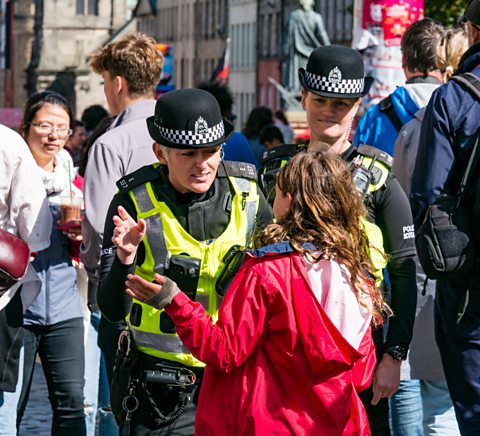Causes and effects of crime
Quick version
Who is affected by crime?
Young males, especially aged 21-25, are the most frequent offenders. Men commit over 80% of crimes.
Young adults (16-24) are more likely to experience both violent and property crimes than older individuals (60+)
Where and when do crimes happen?
Crime rates are higher in deprived urban areas like Glasgow and Dundee, compared to wealthier areas and rural areas.
Violent crime often occurs near workplaces or homes and mostly takes place during the week.
Property crime predominantly happens around the victim’s home, with a similar weekday pattern as violent crime.
Theories of crime
individualist view
- committing crime results from personal choices
- there should be a punishment for their actions
collectivist view
- committing a crime results from factors like poverty, family dynamics, peer pressure, and substance misuse
- people should be offered opportunities to prevent them committing crime.
nature arguement
- biological factors like brain development can make someone more likely to commit crime
nurture argument
- environmental influences such as poverty, peer pressure, and family issues contribute to criminal behaviour
Learn in more depth
Who commits crime?
Crime is more likely to be committed by certain groups of people in society. And some groups are more affected by crime than others.
Statistics show that some groups of people are more likely to commit crime than others. People are more likely to commit crime if they are:
Younger - the peak age for criminal convictions is around 21-25 for males and around 26-30 for females.
- For offences (minor crimes e.g. anti-social behaviour) the peak age is lower for both males and females.
Male – Over 80% of crime is committed by men.
- In 2022, the Scottish Government statistics stated only one-in-six people convicted of a crime were female (17%).
Living in a deprived urban area – Most crime happens in big cities.
- The local authority areas of Dundee, Glasgow, Aberdeen and Edinburgh had the highest number of recorded crimes in Scotland in 2022-23 (Source: Scottish Government).-Within each of these cities, criminality rates vary - the most deprived urban areas consistently have more people involved in crime than those in the least deprived areas.
Who is affected by crime?
The chances of being a victim of a crime are not the same for every person. Some people are more likely to be victims of crime than others.
Scottish Crime and Justice Survey 2019/2020 statistics for violent crime:
- 3.1% of men experienced violent crime compared to 2% of women
- 5.4% of 16-24-year-olds experienced crime compared to 0.6% of people aged 60+ years
- 5.3% of people in the 15% most deprived areas experienced crime compared to 2.1% for the rest of Scotland
- 2.8% of people in urban areas experienced crime compared to 1.4% in rural areas
For property crime the pattern is similar, for example:
- 14% of 16-24-year-olds experienced property crime, compared to 6.4% of people aged 60+ years.
Where and when do crimes happens?
 Image source, IAN GEORGESON / Alamy
Image source, IAN GEORGESON / Alamy Violent crime is most likely to happen:
- in or near a victim’s place of work (32%)
- inside a victim’s home (20%)
- immediately outside a victim’s home (13%)
Just over half (53%) of violent crimes take place during the week, compared to 47% at the weekend.
For property crime:
- two-thirds (66%) took place in and around the victim’s home
- 67% occurred during the week
- 33% at weekends
The above information is from the Scottish Crime and Justice Survey 2019/20.
 Image source, IAN GEORGESON / Alamy
Image source, IAN GEORGESON / Alamy Causes of crime: individualist and collectivist approaches
Two main views are put forward to explain crime – individualist views and collectivist views.
Individualist approach to causes of crime
Individualists are people who tend to focus on individual choices as the reason behind why a crime is committed: if someone chooses to offend, that is their responsibility.
Individualists believe that if someone is caught for committing a crime, they should suffer the consequences through punishment.
Collectivist approach to causes of crime
Collectivists think that inequality in society is the main cause of crime.
They believe inequality leaves some people more vulnerable and at greater risk of being influenced into criminal behaviour.
Collectivists think that people should be offered opportunities to prevent them committing crime.
Both the Scottish and UK governments accept that there are many underlying causes of crime for which the individual is not responsible.
But individuals also need to accept responsibility for their actions. It is the government's job to tackle crime, both its causes and consequences.
Causes of crime: nature and nurture
Criminologists are people who study crime. Criminologists look to explain the reasons why people who commit crime (offenders) behave in the way they do.
Factors including nature, poverty, childhood experience, peer pressure, alcohol and drug misuse, can explain why people break the law.
What is the nature argument for criminal behaviour?
Some criminologists argue that some types of crime can be explained, in part, by the way a person’s brain works. This is the ‘nature’ argument.
For example, younger people tend to have higher rates of crime:
- evidence shows that the brain doesn’t fully develop until the age of 25 years.
- the part of the brain that is last to develop is the prefrontal cortex (the part of the brain that makes decisions).
- therefore, young people’s decision-making ability does not fully develop until later in life
- meaning young people do not always make the best decisions early in life
- it is argued that this is why younger people are more likely to commit crime
There is also evidence to suggest that some people are naturally more likely to commit crime:
- research shows that those who commit crime are more likely to get angry or have less understanding of another person's feelings (empathy)
- it is argued that people with these types of characteristics are often more likely to commit crime.
What is the nurture argument for criminal behaviour?
The nurture argument says that people are more likely to commit crime because of the world around them, i.e. whether or not a person lives in poverty, their family relationships, their friendship group (peers) and their use or misuse of alcohol and drugs.
According to the Scottish Prison Service 17th Prisoner Survey (carried out in 2019), prisoners identified the following factors as having contributed to their offending behaviour:
| Factor | Percentage who felt it contributed to offending |
|---|---|
| Mental health | 27% |
| Alcohol misuse | 24% |
| Drug misuse | 24% |
| Unemployment | 16% |
| Family relationships | 16% |
| Financial difficulties | 15% |
| Lack of support in the community | 14% |
| Accommodation type | 10% |
| Neighbourhood | 9% |
| Peer pressure | 7% |
Are poverty and crime related?
Areas of deprivationLack of basic resources that are considered as being needed for normal life: income, employment, education, health, access to services, housing, freedom from crime, tend to have higher crime rates.
This suggests there is a strong link between poverty and crime.
For example, crime rates are higher in Dundee City, Glasgow City and Aberdeen City than East Dunbartonshire, East Renfrewshire, and the Orkney Islands.
One reason to explain the link between poverty and higher crime rates is that those on a low income may choose to commit crime to get the things they need, for example by shoplifting.
However, most people on low incomes do not commit crime and every year there are examples of wealthy people who commit crime.
Total number of recorded crimes 2022-23 (Source: National Statistics, Scottish Government)
| Local authority | Recorded crimes per 10,000 population |
|---|---|
| Dundee City | 849 |
| Glasgow City | 789 |
| West Dunbartonshire | 651 |
| East Dunbartonshire | 254 |
| East Renfrewshire | 238 |
| Orkney Island | 228 |
How does childhood affect crime?
Recent research into the causes of crime has focused on the extent to which a poor childhood experience can lead to involvement in crime.
What this means is that a child or young person who repeatedly experiences stress in their early life, such as neglect, emotional or physical abuse or parental separation, is far more likely to get involved in crime themselves when older.
Scottish Government research shows that stress in childhood harms healthy brain development. This in turn can lead to risk taking and criminal behaviour.
Does peer pressure lead to crime?
peer pressureThe pressure to conform to the actions of people of the same age and background. can be a cause of crime among some younger people.
According to the Scottish Offenders Index, for minor crime, the peak age of offending is under 20 years. More recent evidence shows that the peak age for all crime is 23 years for men and 30 years for women.
- in 2020-21, the highest number of convictions per 1,000 population was for the 31 to 40 age group overall (18 per 1,000).
- the 21 to 30 age group shows a similar 17 convictions per 1,000 population
- (Source: Criminal proceedings in Scotland, Scottish Government)
In interviews carried out in 2016 at Polmont Young Offenders Institute, some young offenders described the powerful effect of peers - especially the influence of older young people - while they were excluded [from school].
They noted the sometimes rapid escalation of substance abuse, violence and offending at that time.
They spoke of the impact of broken connections with school and with out-of-school activities, role models and pro-social pastimes such as football, which the wider community can provide. (Children and Young People in Custody in Scotland).
Alcohol misuse and crime
There is a close link between alcohol misuse and crime.
When drunk, people may think less about the consequences of their behaviour. They are also less able to control their emotions.
In a study published by Alcohol Focus Scotland in 2021:
- 41% of prisoners said that they were drunk at the time of their crime
- this figure rose to 60% for young offenders
Drug misuse and crime

Many children can be affected by parental drug misuse. The effects of this can include children being at risk of:
- neglect
- emotional abuse
- physical abuse
- long-term physical and mental health issues
Growing up in a household where there is drug and alcohol misuse can seriously affect the life chances of the child.
Many young people from all social backgrounds and all parts of the country experiment and take drugs including tobacco, alcohol and cannabis. They do this for a variety of reasons.
The key factors determining whether people experiment with drugs appear to be the following:
- early years experiences
- family relationships
- family circumstances
- parental attitudes and behaviours

Quiz
Recap what you have learned
People are more likely to commit crime if they are:
- younger - the peak age for criminal convictions is around 21-25 for males and around 26-30 for females.
- male - over 80% of crime is committed by men.
- living in deprived urban areas, especially in cities like Glasgow and Dundee.
Young adults (16-24) are more likely to be victims of both violent and property crimes than older individuals (60+)
Crimes occur in some places and times more than others:
Crime rates are higher in deprived urban areas like Glasgow and Dundee, compared to wealthier areas and rural areas.
Violent crime often occurs near workplaces or homes and mostly takes place during the week.
Property crime predominantly happens around the victim’s home, with a similar weekday pattern as violent crime.
Theories of crime
Individualist:
- committing crime results from personal choices
- there should be a punishment for their actions
Collectivist:
- committing a crime results from factors like poverty, family dynamics, peer pressure, and substance misuse
- people should be offered opportunities to prevent them committing crime.
Some criminologists argue that some types of crime can be explained by the nature vs nurture argument.
The nature argument suggests biological factors like brain development can make someone more likely to commit crime:
- individuals with certain personality traits, like high levels of anger or low empathy, may be naturally more inclined to commit crimes
- young people are more likely to commit crime partly because their brains are not fully developed until about age 25.
The nurture argument focuses on environmental and social factors that could influence someone to commit crime:
- factors such as poverty, family dynamics, peer pressure, and substance/alcohol misuse are seen as significant contributors.
More on Crime and the Law
Find out more by working through a topic
- count3 of 9

- count4 of 9

- count5 of 9

- count6 of 9
